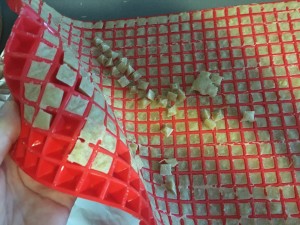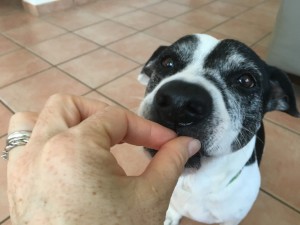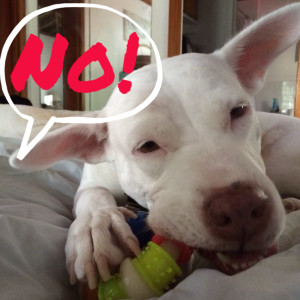What’s Cooking? Healthy Treats Your Dog Will Love!

Would you like to learn how to easily make some delicious (dogs say, “yes!”) and healthy dog treats? I’ve seen several folks talk about oven safe silicone mats and recipes for “fabulous” dog treats so I finally succumbed and decided to give it a try. It helped that the Honest Kitchen dehydrated fish treats and the brand new red silicon mat arrived at the post office as I was on my way to the grocery store. 
So, with mat, Honest Kitchen, and a few more ingredients (I had tapioca flour, cinnamon, natural creamy peanut butter, and olive oil at home and purchased all purpose flour, and unsweetened applesauce) we were ready to go.
As I’d read up, but couldn’t find the original recipe which had prompted the Amazon order, I combined a few. Most said to be sure that the “batter” was more watery than “dough-like” which I did. In hindsight it would be helpful to have a cookie sheet instead of the aluminum foil which I placed under the mat, however after using the spatula to “smooth out” the surface, there was little spillage.
Fifteen minutes in the oven at 350 degrees (F) and they did basically pop right out. I think that some could have used a bit more time in the center to have really just come free without any extra (very minimal) effort, however, the second batch turned out easer, likely due to a pre-heated oven.
 The results were two solid thumbs up from George and Blanca (our deaf dog who leads with her nose!)! Both dogs were keen for more and even the cats took an
The results were two solid thumbs up from George and Blanca (our deaf dog who leads with her nose!)! Both dogs were keen for more and even the cats took an
interest!
 Total time from prep (really quick, grind Honest Kitchen in mini
Total time from prep (really quick, grind Honest Kitchen in mini
food processor for 20 seconds and mix all ingredients) to two batches of 15 minutes each in the oven was an hour’s investment with clean up and all.
We’ll probably re-visit this treat-making adventure as it was reinforcing for the chef and canine participants!



 (how fortunate!) to be invited by my colleague and friend,
(how fortunate!) to be invited by my colleague and friend, 

